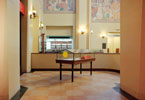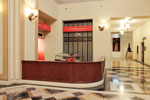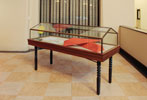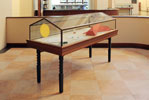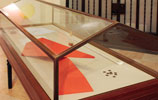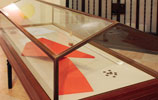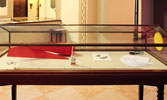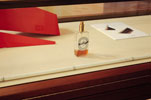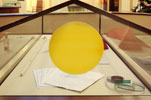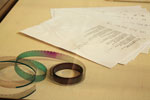works sited
keeping is not collecting
Jason Hwang
with
François Aubart
Valentin Bouré
Olivian Cha
Romain Chenais
David Douard
Luca Francesconi
Benoit Maire
Chris Sharp
Cally Spooner
Jennifer Teets
Dec. 19, 2012 - Jan. 30, 2013
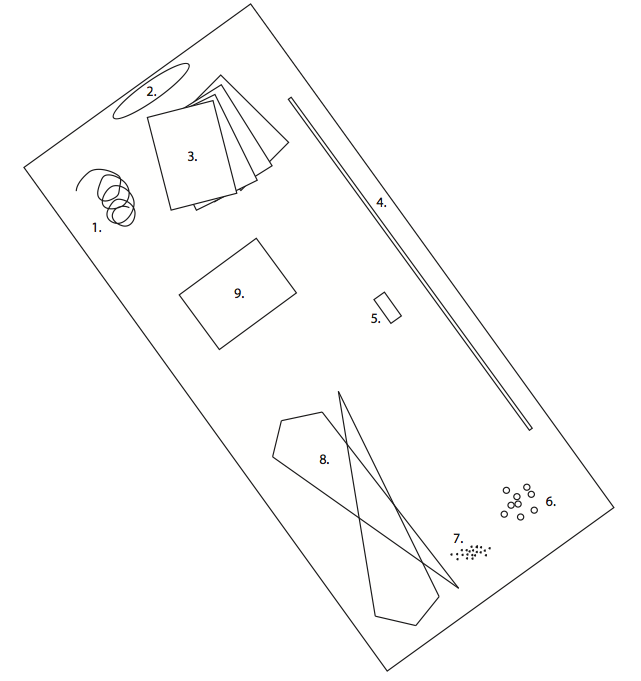
keeping is not collecting
1. When preparing film for a new projection, I have to cut a part of it so that it loads properly into the projector. This becomes a film trim. This trim is usually discarded. The one you have here is the trim of a film showing the shoes of a girl named Dora in movement, dancing so to speak. By chance, while the film was being processed a pink to green gradation happened to appear on the trim. By chance, Dora's hair were the colors pink and green on the day we filmed her. I kept the film trim in memory of this. - Valentin Bouré
2. Sometime around April we hosted our second exhibition titled Y...as in yet, a group show which included the work of LA artist Mateo Tannatt. Mateo's work consisted of a portable radio sitting on the floor, a yellow dot screen printed on our window, and a sheet of paper with the words, "Today or/ tomorrow someone will arrive they will count to a thousand and/or until they want to stop this work may or may not be considered a performance music may or may not be heard this work can be realized by anyone". While installing we encountered a slight problem trying to print the yellow dot. Apparently a silk screen degrades from each use, and even more so if the screen is not handled and cleaned properly. Having very little experience in this matter we managed to do almost everything improperly, so that by the time we were on our third attempt the screen had lost its ability to print a full solid dot. On our fourth attempt we decided that the best solution would be to print the partial dot and paint the rest in, curatorial problem solving at its best. After a few more discussions on what to do and several adjustments later, we printed the dot and somehow it worked better than our previous attempts. We only had to spend a few minutes filling in some areas and voilà we had produced a complete yellow dot on the window of our space. Once the exhibition had concluded we contemplated what to do with Mateo's screen and squeegee. We were either going to hold onto it or discard it. Mateo's work in many ways existed as an event that lasted for the duration of this particular exhibition; what we had leftover was this partially degraded tool. We finally decided to keep it as a memory of our experience. It was the second show in our space and a great moment of triumph for us when the yellow dot appeared magically, almost complete. - Romain Chenais
3. These are the notes made by the jazz pianist Artur Tuznik, for Seven Thirty Till Nine, a performance where I temporarily employed Artur to play a set-list of hits doctored with new lyrics about hired labour and the loss of the collective, at a baby grand piano, in an otherwise empty gallery configured as a bar. Going over and above the call of hired duty, Artur managed to substantially bore and entertain his half distracted gin-drinking audience, alternating between mundane muzak, melancholically delivered pop hits and some incidental free-jazz interludes, in an attempt to reclaim his 'work'. These are his working notes, which we left in the gallery in between 'shifts' (seven thirty till nine, every Thursday). - Cally Spooner
4. When I was a student in Nice I used to walk down the streets with my white stick, this was in 2002-2003. In 2006 I used the stick to make a sculpture and spoke with the curator Claire Staebler about blindness as an allegory for painting while mentioning my past in Nice. She later asked for a picture of me walking down the streets as a blind man which would be used for the invitation card of a group show at the Ricard foundation in Paris. I was in London at this time and employed my friends from the graphic design team Åbäke to take the picture. They asked me to do it at Abbey road, just like the famous picture of the Beatles. We took a few photos and I ended up choosing the one in which I'm on the crosswalk with an old man behind me. I recall overhearing some girls who passed by saying it was a shame I was blind because I was good looking. I titled the photograph, In forecast of October 22. Maki from Åbäke explained to me that I titled it this because october 22nd is my birthdate and I would like to be blind each day of my birthday to be blind to the time that crossed over. I was not sure whether I should use this image for the invitation card and finally decided not to send it. Later my gallerist from London saw the image and put it on their website. Adam Carr, a young curator, liked it and wanted to put the photograph in a group show at Johann Koenig, so I printed the image and the gallery framed it. I was a bit ashamed to make such a contribution since Johann was almost blind at the time. After the opening we went for a beer in a bar near Mitte. I was with Johann in the car and we discussed the work in great detail - the Abbey Road location and its provenance, but somehow never spoke about blindness. - Benoit Maire
5. This is perfume that was given to me by the artist Darius Miksys. I initially gave him a bottle of Vinaigre de toilette as a gift in 2010 and he returned it to me in 2011 filled with an actively aging and evaporating scent made in Nida, Lithuania. The perfume is derived from oakmoss, thalli and other clumping barks. The process, inspired by maceration, relates to Darius' smell-making attempts as a 10 year old child. This particular sample is mixed with vodka and compressed and packaged in a used Vinegar bottle which has acquired the active agent of the former spray, generating a bouquet of aromas. According to Darius it is, "accidentally or site specifically composed, though not reliant on a single ingredient." I’ve held on to the bottle of perfume for the last year or so and it evaporates a little every day. - Jennifer Teets
6. Nancy Lupo's ottoman sculpture from, "A DESIRE TO LEARN ESPERANTO: HAVING A THING to do with Esperanto, Ballantine Beer, both or neither" included a built-in tray that was supposed to be filled with nickels. I had to refill the shallow container every morning because as soon as I put the coins out they would be stolen within the hour. The work was up for a month and I was careful to ration the few $2 nickel rolls she gave me. I'm not sure the thief saw the coins as artwork, I just assumed the immediate monetary value of a handful of nickels outweighed any cultural or aesthetic one. Either way, no one took offense. The ottomans are still in tact in my cubicle, all the nickels are gone. - Olivian Cha
7. A common property of all transparent elements is to filter light, and in this sense to be "a body" without shadow. For everything, losing its shadow (and its limits) is not a neutral passage, but a strong ontological change. In the initial exhibition (from which this powder is from) the protagonist, the first actor, was the sunlight, what circumscribes the object, establishing time and space, made visible by the rhythms of shadows. All elements become merely "circumstance", pure semantic fields without body. A transparent object can filter light, and without shadow (or with a weak shadow), has less presence in reality, compared to one with a shadow. Its limits are feeble, and an object without limits is indeterminate in the continuity of space and time. The shadow is the first step to build and organize time. - Luca Francesconi
8. This piece originally featured in an exhibition I curated (and conceived with Joanna Fiduccia) in Sèvres just outside of Paris at La générale en manufacture in 2010. The exhibition was called, "In which the wind is also a protagonist". It was a show about crimes, clues, and the wind. I was interested in Simon’s piece due to its complex relationship to the wind, and how it actually let the wind inside the exhibition space, incorporating it as an element (in fact, a certain kind of ornate spoon, such as can only be bought in Venice, and which was associated with the Scirocco that purportedly brings the plague to Venice from North Africa in Thomas Mann’s Death in Venice, was inserted in a window in order to keep it open, while the two red, modernist looking sculptures were inspired by two public sculptures Simon had seen in southern California, and which were reminiscent of the Santa Ana wind. These prop the door open, like improbable door stops, making it such that the wind can pass freely in and out of the space). However, the work was in the collection of Andrew Ong, a collector based in New York. This was problematic, because La générale, being a kind of glorified, quasi-institutional squat, could not afford to have the piece shipped from New York to Paris. And even if we could have afforded the Fed-Ex, we would not have been able to properly insure it. So it was completely out of the question. We were about to abandon the inclusion of the work, when Simon suggested the possibility of having a replica/exhibition copy made in Paris with the consent of Andrew. Andrew, whom I had met in New York on a previous trip, generously consented, and we had the replica made strictly according to Simon’s instructions. If I remember rightly, Simon requested that, once the exhibition was over, the copy be transported to him in Berlin. But just large enough to not fit in any but the largest piece of luggage (and therefore wholly inimical to Easy-Jet standards, my preferred, by financial default, European carrier), these two objects languished in my closet in Paris for the next two years, throughout which time I, and apparently Simon, completely forgot about them (One of the objects was significantly damaged in the de-install as well, a factor which contributed to the, admittedly unprofessional, deflation of my inspiration to carry out Simon’s wish). - Chris Sharp
9. When Benoît-Marie Moriceau invited me to organize an exhibition in his studio the place was brand new and the paint had yet to be applied. Clément Rodzielski took advantage of this and asked us to leave a space the size of an A4 sheet of paper unpainted in the middle of one wall. Part of the idea behind the exhibition was to produce artworks from a distance thus Clément mailed us two pieces of geometrically shaped mirror- stickers to be installed within the A4 size space. To make sure we would install it correctly he sent it with a piece of cardboard (A4 sized) with cutout shapes corresponding to the correct placement of the mirrors. When Benoît-Marie sent me back the cardboard and the mirrors I did not know what to do with it, so I just ended up keeping it. - François Aubart
